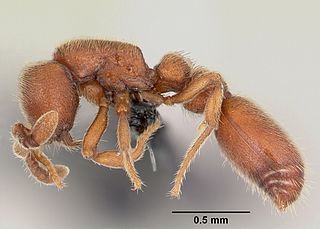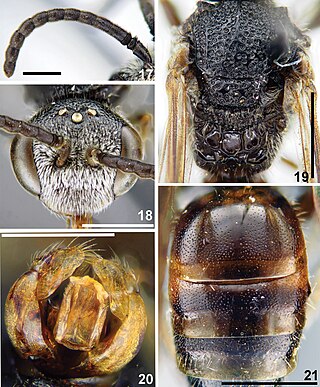Mawella Lagoon Airport is an airport in Dickwella, Sri Lanka.

Mannar is the main town of Mannar District, Northern Province, Sri Lanka. It is governed by an Urban Council. The town is located on Mannar Island overlooking the Gulf of Mannar and is home to the historic Ketheeswaram temple. In the Tamil language, Mannar means the raised place [of sand] which is thought to have come from the geology of Mannar Island which was formed by the accumulation of sand.

Aenictus is a large army ant genus distributed in the Old World tropics and subtropics. It contains about 181 species, making it one of the larger ant genera of the world.

Aenictus ceylonicus is a species of reddish brown army ant found in Southern India, Sri Lanka, Southeast Asia and Australia. They are completely blind and around 3 mm in length. These ants are seen foraging underneath leaf litter in forests and well-vegetated areas, travelling in a trail of in three or more columns alongside each other, in parts of India. Their antennae, as in most species of Aenictus, have ten segments. The scape is long and extends above the head. The head is smooth and shiny. The mesosoma and the head region are dark brown, while the gaster is oval and lighter in colour, nearly translucent. The mesosoma is broad anteriorly and strongly compressed posteriorly. The petiole and the post petiole are large, conical and shining. They occur in rainforests and moist deciduous forests building temporary nests on the ground and in rotting logs.

Aneuretinae is a subfamily of ants consisting of a single extant species, Aneuretus simoni, and 9 fossil species. Earlier, the phylogenetic position of A. simoni was thought to be intermediate between primitive and advanced subfamilies of ants, but recent studies have shown it is the nearest living relative of subfamily Dolichoderinae.

Ooceraea biroi, the clonal raider ant, is a queenless clonal ant in the genus Ooceraea. Native to the Asian mainland, this species has become invasive on tropical and subtropical islands throughout the world. Unlike most ants, which have reproductive queens and mostly nonreproductive workers, all individuals in a O. biroi colony reproduce clonally via thelytokous parthenogenesis. Like most dorylines, O. biroi are obligate myrmecophages and raid nests of other ant species to feed on the brood.
Aenictus gutianshanensis is a Chinese species of army ant in the genus Aenictus. The species is known only from a single colony. Little is known about its biology, but it is probably most closely related to A. vieti.

Sphecodes biroi is a species of bee in the genus Sphecodes, of the family Halictidae.
Aenictus aitkenii is a species of reddish brown army ant found in India and Sri Lanka.
Aenictus fergusoni is a species of reddish brown army ant found in Bangladesh, India, Myanmar, Nicobar Islands, Thailand, Vietnam, and China.

Aenictus gracilis is a species of reddish brown army ant found in Borneo, Indonesia, Malaysia, Philippines, Bangladesh, India, Myanmar, and Sri Lanka.
Aenictus pachycerus is a species of reddish brown army ant found in India, and Sri Lanka.
Aenictus porizonoides is a species of reddish brown army ant found in Sri Lanka.
Crematogaster dohrni, is a species of ant of the subfamily Myrmicinae, which is a widespread species that can be found from Sri Lanka, India, Indonesia, Thailand, and China.
Rhopalomastix escherichi is a species of ant of the subfamily Myrmicinae that can be found in Sri Lanka.
Aenictus currax is a species of dark brown army ant found on New Guinea. A colony of 100,000+ was chronicled on New Guinea in Karema, PNG. The ants form new colonies through fission.





